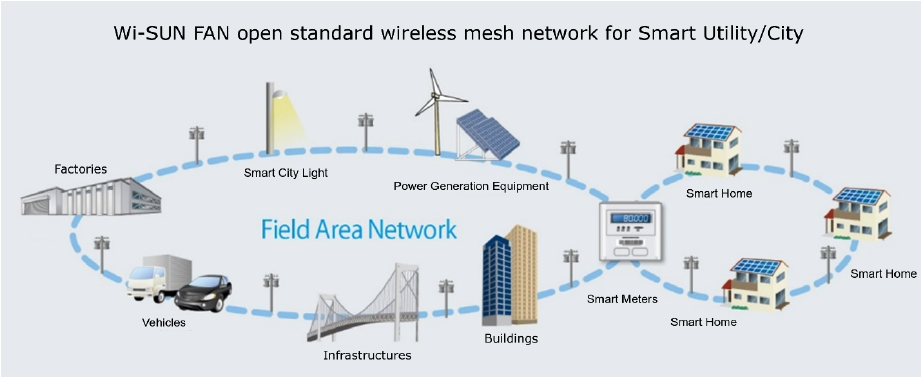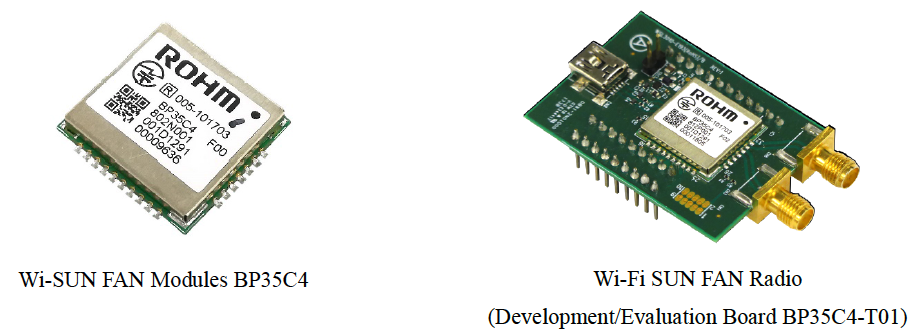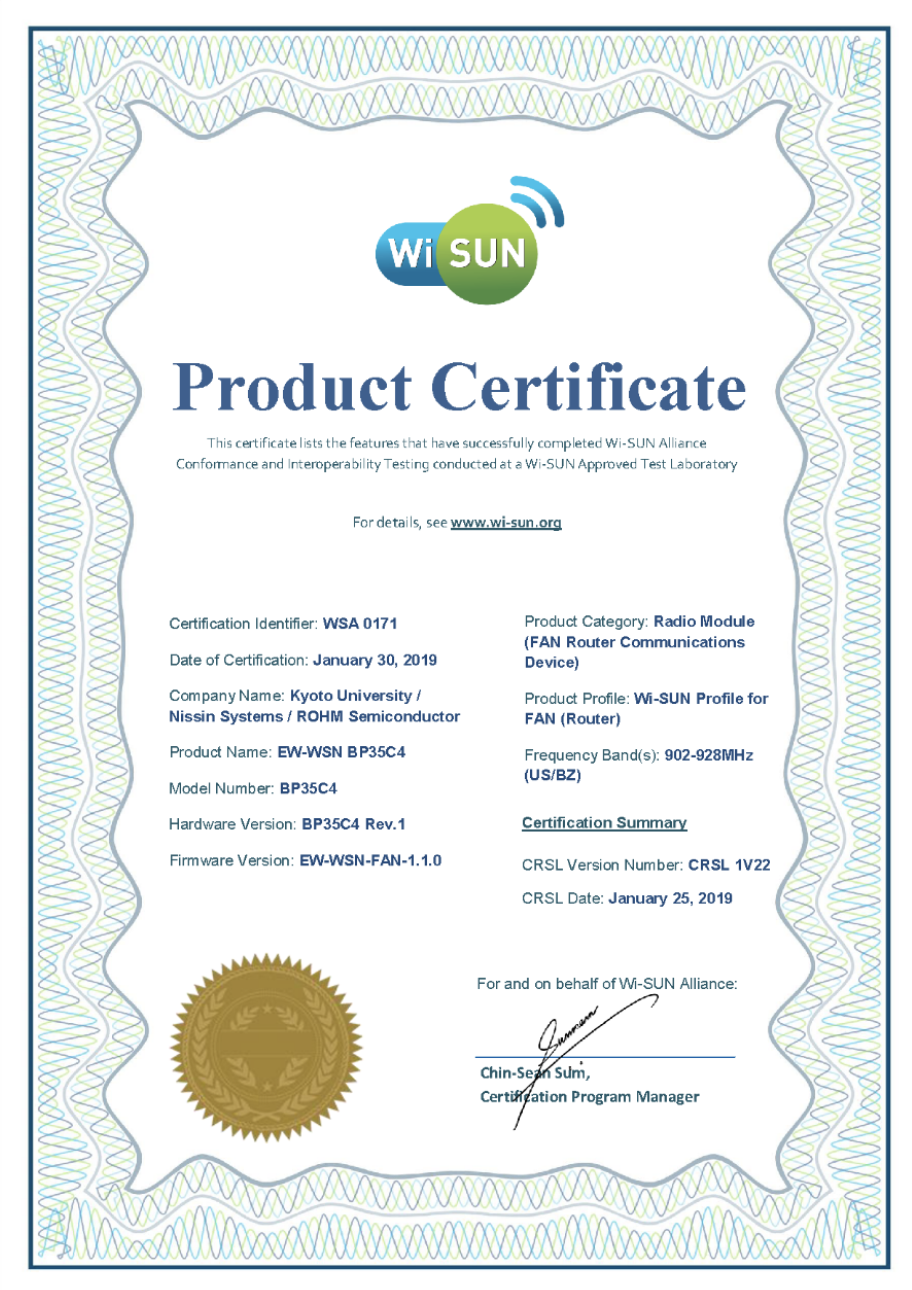






[Home] » [Press Release]
World-First Certification for Wireless Communication Specification Wi-SUN FAN
| Wireless devices equipped with the new international wireless communication specification Wi-SUN FAN (Field Area Network) for the Internet of Things developed jointly by the research group of Professor Hiroshi Harada of the Graduate School of Informatics, Kyoto University (hereinafter Kyoto University), Nisshin Systems Co., Ltd. (hereinafter Nisshin Systems), and ROHM Co., Ltd. (hereinafter ROHM) became one of the world’s first solutions to achieve Wi-SUN FAN certification. |
Background
In order to realize outdoor communication networks such as smart cities and smart grids, high-quality, long-distance and secure network technology is required. Wi-SUN FAN is a new specification of Wi-SUN, an international radio communications project that is the best suited to the construction of IoTs. It is an interoperable communications networking technique for electricity, gas, and water metering, as well as for smart cities and smart grids in various applications such as infrastructure and intelligent transport systems (Fig. 1).
This Wi-SUN FAN is an interoperable low-power IoT wireless communication technology that utilizes low-power wireless transmission technology based on the IEEE 802.15.4g standard and multistage routing technology based on IPv6. On May 16, 2016, the Wi-SUN Alliance, which certifies wireless communication standards for IoTs, technical compatibility, and interconnectivity, established standard specifications, and on November 11, 2016, the three parties announced that they succeeded in basic radio developments compatible with Wi-SUN FAN. The Wi-SUN Alliance then announced its Wi-SUN SUN FAN certification program on October 3, 2018.

|
This achievement
Based on the results of the basic development of Wi-SUN FAN, we developed a radio (Fig. 2) compatible with Wi-SUN FAN technical specifications and certification program, and we passed an IP-based certification test using multi-hop, frequency-hopping, and advanced certification security by using a plurality of different radios from different companies. This radio has the following functions as described in the Wi-SUN FAN Technical Specifications.
- Physical layer and MAC layer corresponding to IEEE 802.15.4/4g/4e required for operation in Japan
- Adaptation layer, network layer, and transport layer established by IETF such as 6LowPAN and IPv6
- Multi-hop communication system using RPL
- Frequency hopping
- RADIUS/AAA high level security
- Multi-vendor interconnectivity

|
With the IEEE802.15.4/4g/4e technologies capable of stable transmission over 1km under the Japanese regulation, this radio is equipped with an international standard for Internet access, which has been introduced in Wi-Fi™ systems, and a multi-hop international standard that realizes multi-stage relay between radios based on IP. This makes it easy to connect sensors, meters, and monitors that make up smart cities and smart metering to the Internet.
This achievement was carried out in the Impulsing Paradigm Change through Disruptive Technologies Program (ImPACT) led by the Council for Science, Technology and Innovation, Cabinet Office. This program was formed by a joint industry-academia consortium called the Next-Generation Wi-SUN Joint Research Consortium, Kyoto. The three parties, based in Kyoto, are Kyoto University, which have a track record of standardization and development of IEEE 802.15.4/4g/4e, Nisshin Systems, which commercializes Wi-SUN-compatible communication middleware, and ROHM, which develops communication modules compatible with the standard.
Outline of Certification Acquisition
- Date and time of certification acquisition: January 30, 2019
- Certification Authority: Wi-SUN Alliance
- Certified testing laboratory: Allion Labs, Inc.
- Certification number: WSA 0171

|
Future development
In the future, the three parties will participate in an interoperability specification verification event sponsored by the Wi-SUN Alliance to contribute to testing for technical conformity and interoperability of the Wi-SUN FAN standard, and to promote further development as industry-academia cooperation projects in Kyoto in order to implement this radio in society. The results will also be displayed at the Wi-SUN Alliance booth in DistribuTECH 2019, the largest power-industry-related event in the United States, which will be held in New Orleans on February 5.
Term descriptions
» IEEE 802.15.4g
An international standard for the wireless communication transmission section (physical layer) that can be installed on sensors, meters, etc. that can be used outdoors and that is necessary for energy management, etc. Transmission of up to 1 km per hop can be realized even in urban areas, and information such as IPv6 can be transmitted at low power consumption. Established by IEEE802.15 Commission. Hiroshi Harada, Kyoto University, was a vice chair of this standardization committee, and is a technical major contributor such as the adoption of the Frame Synchronization Department code in the mandatory standards.
» IETF
A voluntary organization that promotes standardization of Internet technology. Developed from a group that discusses the development of common technical specifications for interconnecting computer systems.
» Wi-SUN Alliance
This is a non-profit organization which develops international wireless communication specifications known as "Wi-SUN profiles" based on the IEEE802.15.4g standard, integrating with other open international standards to realize various applications such as energy management, disaster prevention, factories, etc. Currently, there are more than 200 member companies worldwide. Wi-SUN ECHONET, a communication standard between smart meters and in-house energy-management systems (HEMS), has been adopted by electric power companies nationwide. At present, more than 15 million smart meters equipped with the specifications are shipped. In the future, more than 20 million units will be shipped within the jurisdiction of Tokyo Electric Power Company. See https://www.wi-sun.org for more information.
» Wi-SUN FAN (Field Area Network)
Communication specification for meters capable of multiple hopping (multi-hop) with IPv6 established by the Wi-SUN Alliance. This would be used on smart grid to realize smart metering, distribution automation and infrastructure management, intelligent transportation system, sensors for realizing smart city as represented by smart lighting etc. Version 1 was established by the Wi-SUN FAN Working Group on May 16, 2016. IEEE 802. 15.4g is adopted in the physical layer, IEEE 802. 15.4/4e is adopted in the data link layer, IETF 6LowPAN is adopted in the adaptation layer, IPv6 is adopted in the network layer, UDP is adopted in the ICMPv6, UDP is adopted in the transport layer, and IEEE 802. 1x is adopted as the authenticating method. A comprehensive test specification for ensuring interconnection between manufacturing vendors is also provided.
» Hiroshi Harada Laboratory, Graduate School of Informatics, Kyoto University
Hiroshi Harada, Graduate School of Informatics, Kyoto University, is assigned to the Department of Communications and Communications Systems, Graduate School of Informatics, Kyoto University, and conducts research and development in the digital communications field. In particular, Professor Hiroshi Harada was co-founder (Founder member) at the time of the establishment of the Wi-SUN Alliance in 2012, and is currently engaged in the formulation and dissemination of technical specifications for Wi-SUN systems as chairman of the Wi-SUN Alliance Board of Directors (Chair of the Board) and chairman of the Wi-SUN Alliance HAN WG. Harada Hiroshi Laboratory conducts R&D on Wi-SUN systems in general, and mainly conducts R&D on communication systems, radio wave propagation and transmission, system optimization, and application systems.
» About Nissin Systems
Nissin Systems, a wholly owned subsidiary of Nisshin Electric Co., Ltd. (listed on the First Section of the Tokyo Stock Exchange), is a company that continues to create a new future together with everyone by realizing a valuable smart society in a variety of fields, including energy, based on equipment control and network technologies cultivated through the development of embedded systems.
Https://www.co-nss.co.jp/ of Nisshin Systems' website
Wi-SUN FAN Solution Page https://www.co-nss.co.jp/media/press/wsf/
» About ROHM
ROHM is a manufacturer of semiconductor and electronic components established in 1958. In addition to automotive and industrial equipment, we supply LSIs, discrete components, and electronic components with excellent quality and reliability to diverse markets such as the consumer and telecommunications industries. We also offer solutions that optimize the overall system.
For Wi-SUN FAN, we have been developing radio communication modules compatible with Wi-SUN FAN for mass production, including RF technology compatible with the IEEE802. 15.4g standard, which is indispensable for elemental technology, technology to select the most suitable MCUs for mounting Wi-SUN FAN stacks, and technology to commercialize these modules. So far, we have succeeded in conducting basic experiments on the world's first Wi-SUN FAN compatible radios through joint development with Kyoto University and Nisshin Systems Co., Ltd., and then have been developing small IoT gateways and wide-area information-gathering systems. Looking ahead, ROHM will continue to develop Wi-Fi SUN FAN for wireless-based infrastructures and IoT equipment, which are rapidly expanding.
|
[Inquiries about the Product]
International Public Relations Office, Public Relations Division, General Affairs Department, Kyoto University 36 Yoshida-honmachi, Sakyo-ku, Kyoto 606-8501 Japan Tel: 075-753-5729, Fax: 075-753-2094 E-mail: comms@mail2.adm.kyoto-u.ac.jp |
|
Nisshin Systems Business Strategy Division 293-1, Ayahorikawa-cho, Ayanokouji Sagaru, Horikawa-dori, Shimogyo-ku, Kyoto, 6000-8482 Japan Tel: 075-344-7977 E-mail: release-nss@co-nss.co.jp |
|
Public Relations Division, Media Planning Department, ROHM Co., Ltd. 21, Saiin Mizosaki-cho, Ukyo-ku, Kyoto 615-8585 Japan Tel: 075-311-2121 Fax: 075-311-1317 E-mail: press@rohm.co.jp |